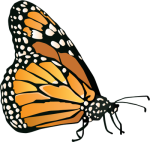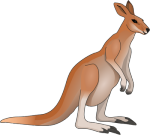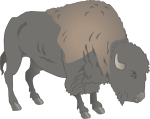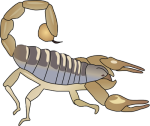Top ten animal symbols: Whales, bison, butterflies and frogs
Bill Dennison ·This is the fifth blog post in a series of blog posts which celebrate the IAN symbol library by highlighting some of the most interesting symbols. Previous blog posts have focused on marine flora and fauna, birds and trees. This blog post focuses on terrestrial animals, from small (e.g., butterflies) to large (e.g., whales).
 1. The Monarch Butterfly (Danaus plexippus) was the first butterfly that I learned growing up in Ohio. We had milkweed plants in our yard, which attracted Monarchs. I learned to distinguish the Monarch from the mimic Viceroy Butterfly and I was amazed to learn that these fragile little animals could migrate all the way to Mexico. I remember a particularly interesting boat trip that I took from Woods Hole on Cape Cod to Newport, Rhode Island and then onto Montauk, Long Island in the autumn of 2005. Hurricane Gloria had just passed over Long Island while I held on for dear life, anchored in Hadley Harbor, a small embayment in the Elizabeth Islands. There were hundreds of Monarch Butterflies that had gotten blown off their migration surrounding my boat, many miles from shore. They would alight briefly and then head on their way, presumably heading back south. This beautiful symbol was drawn by Tracey Saxby.
1. The Monarch Butterfly (Danaus plexippus) was the first butterfly that I learned growing up in Ohio. We had milkweed plants in our yard, which attracted Monarchs. I learned to distinguish the Monarch from the mimic Viceroy Butterfly and I was amazed to learn that these fragile little animals could migrate all the way to Mexico. I remember a particularly interesting boat trip that I took from Woods Hole on Cape Cod to Newport, Rhode Island and then onto Montauk, Long Island in the autumn of 2005. Hurricane Gloria had just passed over Long Island while I held on for dear life, anchored in Hadley Harbor, a small embayment in the Elizabeth Islands. There were hundreds of Monarch Butterflies that had gotten blown off their migration surrounding my boat, many miles from shore. They would alight briefly and then head on their way, presumably heading back south. This beautiful symbol was drawn by Tracey Saxby.
 2. The Diamondback Terrapin (Malaclemys centrata) is the Maryland state reptile and the University of Maryland sports teams are known as the 'Terps', short for Terrapin. The slogan is 'Fear the Turtle', based on a drawing of a ferocious looking turtle, and the mascot is a turtle named 'Testudo'. The 'diamondback' refers to the beautiful patterns on their shells. They inhabit Chesapeake Bay where they used to be collected for turtle soup. Terrapins inhabit the entire Gulf coast of the U.S., and the East coast as far north as Cape Cod. An invasion of Terrapins on the runway of JFK airport in New York City once delayed flights. At times you can see dozens of these animals popping their heads above the water surface to breathe and have a look around, typically next to salt marshes. This symbol was drawn by Tracey Saxby.
2. The Diamondback Terrapin (Malaclemys centrata) is the Maryland state reptile and the University of Maryland sports teams are known as the 'Terps', short for Terrapin. The slogan is 'Fear the Turtle', based on a drawing of a ferocious looking turtle, and the mascot is a turtle named 'Testudo'. The 'diamondback' refers to the beautiful patterns on their shells. They inhabit Chesapeake Bay where they used to be collected for turtle soup. Terrapins inhabit the entire Gulf coast of the U.S., and the East coast as far north as Cape Cod. An invasion of Terrapins on the runway of JFK airport in New York City once delayed flights. At times you can see dozens of these animals popping their heads above the water surface to breathe and have a look around, typically next to salt marshes. This symbol was drawn by Tracey Saxby.
 3. The symbol of a Dugong (Dugong dugon) is one of first that was created by Diana Kleine for the Marine Botany group at the University of Queensland. Nearly a thousand dugong inhabit Moreton Bay, and they feed extensively on seagrass meadows. These manatee cousins are shy marine mammals and quite powerful swimmers. One of my favorite places in the entire world is Moreton Banks near Blue Hole in Eastern Moreton Bay largely because there are so many dugong typically feeding on seagrasses there.
3. The symbol of a Dugong (Dugong dugon) is one of first that was created by Diana Kleine for the Marine Botany group at the University of Queensland. Nearly a thousand dugong inhabit Moreton Bay, and they feed extensively on seagrass meadows. These manatee cousins are shy marine mammals and quite powerful swimmers. One of my favorite places in the entire world is Moreton Banks near Blue Hole in Eastern Moreton Bay largely because there are so many dugong typically feeding on seagrasses there.
 4. The Australian Green Tree Frog (Litoria caerulea) is one of my favorite Australian animals. One of the best ways to view them is when they are attached to a window with their little sucker feet. They are quite docile and can grow to a large size. There was a large fat green tree frog that took up residence in a toilet bowl in a seldom used bathroom below the old research station at Stradbroke Island, Queensland. He would hang out up under the rim and when the toilet was flushed, he would slide down part of the way, and then crawl back under the rim. Needless to say, it was a shock to anyone using that toilet for the first time. This symbol was drawn by Dieter Tracey.
4. The Australian Green Tree Frog (Litoria caerulea) is one of my favorite Australian animals. One of the best ways to view them is when they are attached to a window with their little sucker feet. They are quite docile and can grow to a large size. There was a large fat green tree frog that took up residence in a toilet bowl in a seldom used bathroom below the old research station at Stradbroke Island, Queensland. He would hang out up under the rim and when the toilet was flushed, he would slide down part of the way, and then crawl back under the rim. Needless to say, it was a shock to anyone using that toilet for the first time. This symbol was drawn by Dieter Tracey.
 5. The Sea Otter (Enhydra lutris) is a playful and cute marine mammal that lives along the coastlines of the North Pacific Ocean. I loved watching them eat sea urchins and abalone when I was working for the U.S. Fish & Wildlife Service in Southeast Alaska. They would dart around among the long fronds of kelp and roll onto their backs to feed. They are voracious eaters, as they have a high metabolism and live in cold water, so they need to eat up to a quarter of their body weight daily. They were hunted nearly to extinction for their furs, and the early settlement of Alaska by Russia was largely to hunt sea otters. This symbol of an otter floating on its back was drawn by Tracey Saxby.
5. The Sea Otter (Enhydra lutris) is a playful and cute marine mammal that lives along the coastlines of the North Pacific Ocean. I loved watching them eat sea urchins and abalone when I was working for the U.S. Fish & Wildlife Service in Southeast Alaska. They would dart around among the long fronds of kelp and roll onto their backs to feed. They are voracious eaters, as they have a high metabolism and live in cold water, so they need to eat up to a quarter of their body weight daily. They were hunted nearly to extinction for their furs, and the early settlement of Alaska by Russia was largely to hunt sea otters. This symbol of an otter floating on its back was drawn by Tracey Saxby.
 6. The Polar Bear (Ursus maritimus) is one of the most iconic animals on the planet. As its Latin species name suggests, this marine bear spends much of its time in water or on ice. When I spent a summer on the North Slope of Alaska, the biggest fear that the Native Americans (Iniuts) and the old experienced 'Sourdoughs' had was of polar bears. We always kept a lookout watching for polar bears when we were out sampling on the ice. They have become the symbol for climate change, and in a previous blog, I described a melting ice sculpture used to highlight climate change. This symbol was drawn by Tracey Saxby.
6. The Polar Bear (Ursus maritimus) is one of the most iconic animals on the planet. As its Latin species name suggests, this marine bear spends much of its time in water or on ice. When I spent a summer on the North Slope of Alaska, the biggest fear that the Native Americans (Iniuts) and the old experienced 'Sourdoughs' had was of polar bears. We always kept a lookout watching for polar bears when we were out sampling on the ice. They have become the symbol for climate change, and in a previous blog, I described a melting ice sculpture used to highlight climate change. This symbol was drawn by Tracey Saxby.
 7. The Humpback Whale (Megaptera novaeangliae) is easily recognizable due to its white pectoral fins, its iconic humped back when sounding, and its gregarious behavior. We saw humpbacks throughout the intercoastal waterways of Southeast Alaska and feeding in the Stellwagon Banks off Cape Cod, Massachusetts. Humpback whales have amazing behaviors, including producing bubble curtains to corral fish, and breaching, spy hopping and slapping their flukes on the water surface. The symbol was drawn by Tracey Saxby.
7. The Humpback Whale (Megaptera novaeangliae) is easily recognizable due to its white pectoral fins, its iconic humped back when sounding, and its gregarious behavior. We saw humpbacks throughout the intercoastal waterways of Southeast Alaska and feeding in the Stellwagon Banks off Cape Cod, Massachusetts. Humpback whales have amazing behaviors, including producing bubble curtains to corral fish, and breaching, spy hopping and slapping their flukes on the water surface. The symbol was drawn by Tracey Saxby.
 8. The Red Kangaroo (Macropus rufus) is the largest kangaroo and the largest marsupial mammal on the planet. These majestic animals live throughout the interior of Australia, out in the open country including the desert. You only really see them at dusk or early evening, as they rest in the shade during the hot days. There are many conservationists in Australia who promote the consumption of kangaroo meat over beef or lamb. In addition to kangaroo meat being very lean and delicious, the cloven hoofs of cattle and sheep destroy the fragile soil surface, while the marsupial's soft padded feet leave the mats of cyanobacteria and soil microbes intact. So runoff from cattle or sheep grazing lands is more pronounced than lands with native marsupials. This symbol was drawn by Dieter Tracey.
8. The Red Kangaroo (Macropus rufus) is the largest kangaroo and the largest marsupial mammal on the planet. These majestic animals live throughout the interior of Australia, out in the open country including the desert. You only really see them at dusk or early evening, as they rest in the shade during the hot days. There are many conservationists in Australia who promote the consumption of kangaroo meat over beef or lamb. In addition to kangaroo meat being very lean and delicious, the cloven hoofs of cattle and sheep destroy the fragile soil surface, while the marsupial's soft padded feet leave the mats of cyanobacteria and soil microbes intact. So runoff from cattle or sheep grazing lands is more pronounced than lands with native marsupials. This symbol was drawn by Dieter Tracey.
 9. The American bison (Bison bison), or buffalo, is an iconic animal that used to form massive herds in the grasslands of the Great Plains of the United States. They were hunted nearly to extinction by the white settlers, after the Native Americans had been living sustainably with bison for 20,000 years. The meat from bison, like kangaroo, is lean and delicious, and you can purchase bison burgers at the American Indian Museum, part of the Smithsonian Museum in the National Mall, Washington, D.C. This symbol was drawn by Tracey Saxby.
9. The American bison (Bison bison), or buffalo, is an iconic animal that used to form massive herds in the grasslands of the Great Plains of the United States. They were hunted nearly to extinction by the white settlers, after the Native Americans had been living sustainably with bison for 20,000 years. The meat from bison, like kangaroo, is lean and delicious, and you can purchase bison burgers at the American Indian Museum, part of the Smithsonian Museum in the National Mall, Washington, D.C. This symbol was drawn by Tracey Saxby.
 10. The Scorpion is a spider common in the American Southwest, with almost 2,000 species. They have a distinctive curved tail, with a poisonous stinger at the end of the tail. The constellation Scorpio (or Scorpius) containing the red star Antares is one of the easier to recognize due to the curved tail and is in the Zodiac. This symbol was drawn by Tracey Saxby.
10. The Scorpion is a spider common in the American Southwest, with almost 2,000 species. They have a distinctive curved tail, with a poisonous stinger at the end of the tail. The constellation Scorpio (or Scorpius) containing the red star Antares is one of the easier to recognize due to the curved tail and is in the Zodiac. This symbol was drawn by Tracey Saxby.
About the author
Bill Dennison

Dr. Bill Dennison is a Professor of Marine Science and Interim President at the University of Maryland Center for Environmental Science (UMCES).